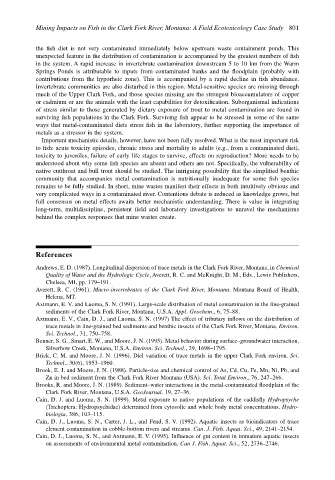Page 821 - The Toxicology of Fishes
P. 821
Mining Impacts on Fish in the Clark Fork River, Montana: A Field Ecotoxicology Case Study 801
the fish diet is not very contaminated immediately below upstream waste containment ponds. This
unexpected feature in the distribution of contamination is accompanied by the greatest numbers of fish
in the system. A rapid increase in invertebrate contamination downstream 5 to 10 km from the Warm
Springs Ponds is attributable to inputs from contaminated banks and the floodplain (probably with
contributions from the hyporheic zone). This is accompanied by a rapid decline in fish abundance.
Invertebrate communities are also disturbed in this region. Metal-sensitive species are missing through
much of the Upper Clark Fork, and those species missing are the strongest bioaccumulators of copper
or cadmium or are the animals with the least capabilities for detoxification. Suborganismal indications
of stress similar to those generated by dietary exposure of trout to metal contamination are found in
surviving fish populations in the Clark Fork. Surviving fish appear to be stressed in some of the same
ways that metal-contaminated diets stress fish in the laboratory, further supporting the importance of
metals as a stressor in the system.
Important mechanistic details, however, have not been fully resolved. What is the most important risk
to fish: acute toxicity episodes, chronic stress and mortality to adults (e.g., from a contaminated diet),
toxicity to juveniles, failure of early life stages to survive, effects on reproduction? More needs to be
understood about why some fish species are absent and others are not. Specifically, the vulnerability of
native cutthroat and bull trout should be studied. The intriguing possibility that the simplified benthic
community that accompanies metal contamination is nutritionally inadequate for some fish species
remains to be fully studied. In short, mine wastes manifest their effects in both intuitively obvious and
very complicated ways in a contaminated river. Contentious debate is reduced as knowledge grows, but
full consensus on metal effects awaits better mechanistic understanding. There is value in integrating
long-term, multidiscipline, persistent field and laboratory investigations to unravel the mechanisms
behind the complex responses that mine wastes create.
References
Andrews, E. D. (1987). Longitudinal dispersion of trace metals in the Clark Fork River, Montana, in Chemical
Quality of Water and the Hydrologic Cycle, Averett, R. C. and McKnight, D. M., Eds., Lewis Publishers,
Chelsea, MI, pp. 179–191.
Averett, R. C. (1961). Macro-invertebrates of the Clark Fork River, Montana. Montana Board of Health,
Helena, MT.
Axtmann, E. V. and Luoma, S. N. (1991). Large-scale distribution of metal contamination in the fine-grained
sediments of the Clark Fork River, Montana, U.S.A. Appl. Geochem., 6, 75–88.
Axtmann, E. V., Cain, D. J., and Luoma, S. N. (1997) The effect of tributary inflows on the distribution of
trace metals in fine-grained bed sediments and benthic insects of the Clark Fork River, Montana. Environ.
Sci. Technol., 31, 750–758.
Benner, S. G., Smart, E. W., and Moore, J. N. (1995). Metal behavior during surface–groundwater interaction,
Silverbow Creek, Montana, U.S.A. Environ. Sci. Technol., 29, 1698–1795.
Brick, C. M. and Moore, J. N. (1996). Diel variation of trace metals in the upper Clark Fork environ. Sci.
Technol., 30(6), 1953–1960.
Brook, E. J. and Moore, J. N. (1988). Particle-size and chemical control of As, Cd, Cu, Fe, Mn, Ni, Pb, and
Zn in bed sediment from the Clark Fork River Montana (USA). Sci. Total Environ., 76, 247–266.
Brooks, R. and Moore, J. N. (1989). Sediment–water interactions in the metal-contaminated floodplain of the
Clark Fork River, Montana, U.S.A. GeoJournal. 19, 27–36.
Cain, D. J. and Luoma, S. N. (1999). Metal exposure to native populations of the caddisfly Hydropsyche
(Trichoptera: Hydropsychidae) determined from cytosolic and whole body metal concentrations. Hydro-
biologia, 386, 103–115.
Cain, D. J., Luoma, S. N., Carter, J. L., and Fend, S. V. (1992). Aquatic insects as bioindicators of trace
element contamination in cobble-bottom rivers and streams. Can. J. Fish. Aquat. Sci., 49, 2141–2154.
Cain, D. J., Luoma, S. N., and Axtmann, E. V. (1995). Influence of gut content in immature aquatic insects
on assessments of environmental metal contamination. Can J. Fish. Aquat. Sci., 52, 2736–2746.

